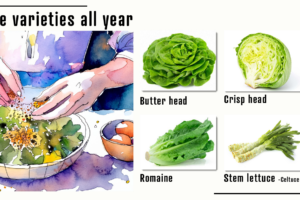
The benefits of cover crops
In the old days across cultures a farmer would leave ground that had been cultivated over a number of years to fallow. This was the practice of leaving arable land to vegetate by at least a couple of plant cycles. It was a clever practice because it gave the soil a chance to regenerate the soil life and nutrients it needed to be productive again. We now have the benefit of understanding the science behind this and being specific in what we allow to fallow and to what stage to maximise the benefits. When I was researching this topic I was actually mind-blown with some of biological strategies some crops use for their own survival and abundance.
Cover crops offer a range of amazing benefits for gardening.
These are plants grown primarily to benefit the soil and the overall health of your garden, rather than for harvesting. Here are some of the advantages of using cover crops in gardening:
- Soil Improvement:
- Soil Erosion Prevention: Cover crops help protect your garden soil from erosion, especially during heavy rains or windy conditions, by covering the ground with their foliage and roots.
- Enhanced Soil Structure: Certain cover crops, like legumes, have deep root systems that break up compacted soil, improving its structure and aeration. They are also specialists at taking nitrogen from the atmosphere and putting it into the soil.
- Increased Organic Matter: When cover crops are turned into the soil, they add organic matter, which improves soil fertility and water retention. If you don’t want to manually turn your soil, you can cut the crop as low as possible and add a tarpaulin over it for a few weeks and let the worms do the incorporating for you. Alternately, you can crimp the crop which is a method of crushing the stem to prevent any further growth or just leave the organic matter on top and make a space for your new seedlings.
- Weed Suppression:
- Competitive Exclusion: Dense cover crop growth can outcompete weeds for light, water, and nutrients, reducing weed pressure in your garden.
- Allelopathy: This is Papatūānuku being pretty damned amazing. Some cover crops release chemicals that inhibit the growth of weeds, acting as natural weed suppressors. Allelopathic effects strong enough to contribute significantly to weed control in field conditions have been documented for cereal rye and other winter cereal grains, sorghums, and sorghum-sudangrass hybrids, brassica family, including rapeseed, mustards, and radishes. Here’s a really quick read from the USDA.
- Nutrient Management:
- Nitrogen Fixation: Legume cover crops, like clover and peas, have symbiotic relationships with nitrogen-fixing bacteria, enriching the soil with nitrogen, a crucial nutrient for plant growth.
- Nutrient Cycling: Cover crops can scavenge and store excess nutrients in the soil, preventing leaching and making them available to subsequent crops.
- Pest Management:
- Beneficial Insects: Some cover crops attract beneficial insects that help control garden pests, reducing the need for chemical pesticides.
- Trap Cropping: Certain cover crops can act as “trap crops,” luring pests away from your main crops.
- Disease Suppression:
- Biofumigation: Brassica cover crops, like mustard and radish, release compounds that suppress soil-borne diseases and pests.
- Improved Water Management:
- Water Retention: The root systems of cover crops improve soil’s water-holding capacity, reducing water runoff and helping your garden tolerate dry periods.
- Enhanced Biodiversity:
- Diverse Plant Communities: Cover crops can contribute to biodiversity by introducing different plant species to your garden, supporting a variety of insects and wildlife. Permaculture gardens use this principle effectively. If your permaculture agrden is in its early stages, lightly sowing a packet of manure crop seeds would help your garden considerably and at considerably less cost than purchasing the standard size seed packets.
- Reduced Soil Compaction:
- Deep Roots: Some cover crops penetrate deep into the soil, helping to alleviate compaction issues. I especially appreciate this with clay soil as it compacts easily.
- Season Extension:
- Overwintering: Some cover crops, like winter rye, can be sown in autumn and provide ground cover during the winter months, protecting the soil and adding organic matter.
- Improved Aesthetics:
- Green Cover: A cover crop can keep your garden looking green and attractive even when your main crops are not in season.
Environmental considerations

Most of the land in New Zealand is suffering from soil degredation. If stated in economic terms it means it is decreasing in value. Land without biodiversity will suffer from soil degredation through erosion. You can see it whenever look at rivers like the Waikato or Rangitaki because at their source they are clear, but it doesn’t take long before they turn brown. That is our countries wealth being washed out to sea. We need soil that can hold moisture and nutrients and the only way to do this is increase the health of our soil en masse. Here are the stats to back up this claim.
Summary of the key findings from the report
- Our soil is affected by erosion and intensive agriculture:
- 192 million tonnes of soil are lost every year from erosion – 44 percent of this is from pasture.
- Soil quality testing shows 2 out of 7 indicators give reason for concern, with 48 percent of tested sites outside the target range for phosphorus content and macroporosity.
Land report highlights issues with soil degradation
19 April 2018,
Statistics NZ
Common plants used as cover or manure crops
Several plant species are commonly used as cover crops or green manure crops in gardening and agriculture due to their specific benefits for soil improvement and overall garden health. Here are some of the most commonly used cover crops and green manure crops:

- Legumes:
- Clover (e.g., red clover, white clover): Fixes nitrogen in the soil due to their symbiotic relationship with nitrogen-fixing bacteria.
- Austrian Winter Pea: A nitrogen-fixing legume that also adds organic matter to the soil.
- Grasses:
- Rye: Known for its extensive root system that helps prevent erosion and scavenges nutrients.
- Annual Ryegrass: Quick-growing and effective at reducing erosion and improving soil structure.
- Oats: Helps with weed suppression and adds organic matter to the soil.
- Brassicas:
- Mustard: Releases biofumigant compounds that can suppress soil-borne diseases and pests.
- Radish: Penetrates deep into the soil, improving aeration and breaking up compaction.
- Buckwheat: Grows rapidly, suppresses weeds, and attracts pollinators with its flowers.
- Phacelia: An excellent choice for attracting beneficial insects like bees and predatory insects.
- Crimson Clover: Fixes nitrogen and is often used as a winter cover crop.
- Vetch: A nitrogen-fixing legume that can add substantial organic matter to the soil.
- Hairy Vetch: Fixes nitrogen, suppresses weeds, and adds organic matter.
- Winter Pea: Fixes nitrogen and provides good ground cover during the winter months.
- Sunflower: Can improve soil structure and add organic matter, plus attracts pollinators.
- Buckwheat: A fast-growing summer cover crop that suppresses weeds and attracts beneficial insects.
- Triticale: A cross between wheat and rye, known for its erosion control and soil improvement properties.
The choice of cover crop or green manure crop depends on your specific goals and the growing conditions in your area. Some cover crops are better suited for certain climates, soil types, and gardening objectives. Rotating different cover crops in your garden can also provide a range of benefits and help improve soil health over time.
Tag:cover crop, over-wintering




